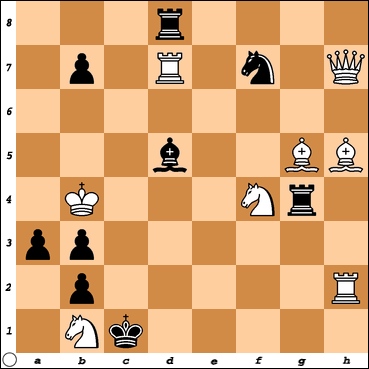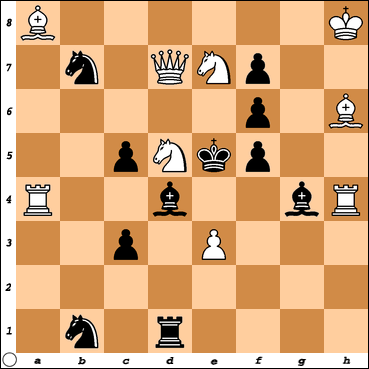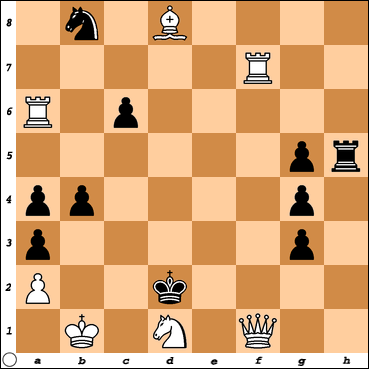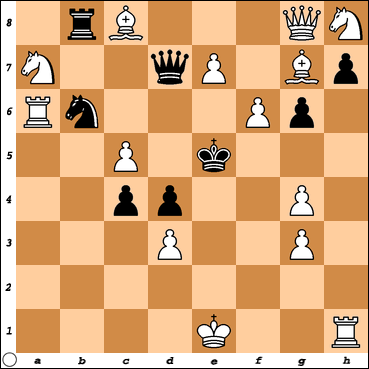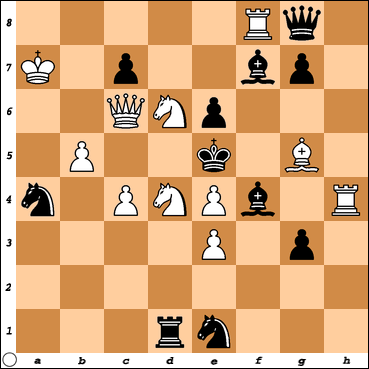- 最後登錄
- 2024-11-21
- 在線時間
- 1917 小時
- 註冊時間
- 2009-10-20
- 閱讀權限
- 80
- 精華
- 0
- UID
- 7156811
     
- 帖子
- 6483
- 積分
- 31512 點
- 潛水值
- 115573 米
| 若瀏覽伊莉的時侯發生問題或不正常情況,請使用Internet Explorer(I.E)。
❈ ❈ ❈
(三)
E. Cook, Illustrated London News, 1855,三步殺
按下滑鼠左鍵掃出答案:
★1.e8=B!(若 1. e8=Q??則欠行和棋)
1... Ke6 2.f8=B Kf5 3.Bd7#★
(四)
Samuel Loyd, Boston Globe, 1876,三步殺
★1. e8=N+!
1... Kxh8 2.d8=N N any 3.Nf7#
1... Kh6 2.d8=N N any 3.Ndf7 #
1... Kf8 2 d8=N N any (or Ke7) 3.Ng6#★
做以上四題,你也許發現棋題的思考技巧在實戰下棋也用得著呢!如果喜歡,你可以下載一本(PDF 格式,用 看)。其實,棋題除了以上那種「標準型」以外,還有兩種:「自殺型」(self-mate)和「助殺型」(help-mate),「自殺型」是「標準型」相反,你替白棋先手,無論黑棋怎麼走也會殺白棋。「助殺型」時你同時控制黑白兩方(黑先手),在限著內殺黑棋。不過這兩種由於較少見,所以不介紹了,儘管我認為它們也很有趣。
(全文完)
原文 url:
另可參考:
大量電子棋題集鏈結:
❈ ❈ ❈ ❈ ❈
【附錄】What is a Chess Problem? by Peter Wong
【注:以下一文用的記譜法,馬(騎士Knight)的代號是「S」(騎士德文Springer的第一個字母)而非「N」,這是棋題界的習慣】
What is a Chess Problem?
by Peter Wong
The best games of chess are considered beautiful. They are admired, and replayed around the world by enthusiasts for that reason, apart from the practical use of studying such games. Yet when we play a game, the only real consideration is how to win it, never mind whether the method of winning is attractive or not. What if we devise a position specifically to demonstrate a beautiful or artistic chess idea? That, in fact, is what occurs in the composition of a chess problem. When you solve such a problem, its composer’s aesthetic intent is revealed in the play of the solution.
So chess problems – also known as chess compositions – are enjoyed on two levels. On a basic level, they work as challenging puzzles. You are given a position and an accompanying task, such as “White to play and mate in two moves”, that must be fulfilled. On a higher level, problems are aesthetic works designed to show an interesting theme – the composition’s main idea. How exactly are themes artistic? It varies, but important factors include subtlety, elegance, economy, paradox, and unity of play. The latter concept of unity is especially noteworthy; most good problems have multiple variations that are related to each other in some way, to create a harmonious impression.
Chess problems come in a variety of genres, the most common of which is the directmate. In this type of problem, White plays first and forces mate in the specified number of moves, against any Black defence. Only one of White’s first moves is able to achieve this, and the solver’s task is to discover this unique move, called the key. If another move, unintended by the composer, solves the problem too, that alternative move is called a cook, and the problem becomes unsound. Such faulty problems, however, are rarely seen nowadays (especially in directmates) because of the practice of computer-testing, which ensures that cooks are eliminated.
1. Otto Wurzburg
American Chess Bulletin 1942
3rd Hon. Mention
Mate in 22
Let us consider our first example, 1, a . The problem’s or task is given next to the diagram as “Mate in 2”, indicating it’s a directmate and White must mate by the second move. The solution begins with 1.Kc2! – the '!' signifies the key – after which the is 2.Sb3 mate. Black can parry this threat with various , but these moves enable White to mate in other ways. For example, 1…bxc3 2.Bxc3 – the two moves here, Black’s defence and White’s correct response, constitute a . The main variations of this problem are 1…Bf5+ 2.Se4, 1…R1g2+ 2.S1e2,and 1…R5g2+ 2.S3e2. These lines represent the thematic play because they share a number of elements: Black checks, but unguards a white piece (rook or bishop) that’s training on the black king, allowing White to answer the check by interposing a knight, and discover mate at the same time. Such a tactic, in which White stops a check by interposition, and gives check as well with the same move, is known as a , and its recurring use is the theme of this problem.
Various conventions apply to key-moves in directmates, and knowing them will assist you when solving this type of problem. The desired feature of subtlety means that keys are very unlikely to be checks. Keys that capture a piece are almost unheard of, for the same reason, though the capture of a pawn is acceptable. In contrast to obviously aggressive keys that are frown upon, keys that apparently weaken White or strengthen Black are viewed as good in the artistic sense. Though not all directmates are successful in incorporating them, you should keep in mind the possibility of such paradoxical keys. A perfect illustration is 1, which has an excellent key because it exposes the white king to numerous checks.
2. William Shinkman
The Problemist 1944
Mate in 2
Another major consideration when analysing a problem is whether the key creates a threat or sets up a . The former is already exemplified by 1, a threat-problem. In a block-problem, the key carries no threat but is a that puts Black in zugzwang. In such a position, every possible move by Black entails a weakness, which is exploited by White due to Black’s compulsion to move. Problem 2 is an example. Its key 1.c5! doesn’t threaten an immediate mate, but all moves by the black knight commit some kind of error that allows a mating reply. The variations 1…Sd4 2.Rxd4, 1…Sf4 2.Rxf4, 1…Sg5 2.Rxg5, and 1…Sg7 2.Sxg7 are similar – White discovers check and captures the knight to stop it from interfering with the bishop mate. 1…Sxc5 2.Rc4 and 1…Sxf8 2.Rg8 see the white rook pinning the knight, to prevent its return to e6. In the remaining two lines, 1…Sc7 2.b7 and 1…Sd8 2.Sd6, the errors committed by the knight are called : a black piece obstructs a square next to the black king, freeing a white piece that was guarding it to give mate. When a black knight makes its maximum number of eight moves in a problem and induces eight different white responses, as here, the theme is produced.
Looking at the problems in this article, you may be struck by how the positions seem “artificial” and far removed from an actual game of chess. That only highlights how problem composition is a field distinct from the competitive game and also from game-position exercises. Chess problems are constructed in accordance with their own principles. A particularly important one of such principles is economy of force, which holds that for any given idea shown in a problem, the number of pieces used should be minimised, and that every piece should serve to bring about that idea or to ensure soundness. That the resulting problem positions do not resemble game situations is regarded as irrelevant. Nevertheless, another convention of problems links them directly to the game. Problem positions are required to be legal, i.e. they could have arisen from the opening array, however unlikely the players’ moves may have been in reaching these positions.
3. Charles Ouellet
The Problemist 1987
Mate in 2
A pawn on its starting rank has the potential to make four different moves – two forward steps, and two captures. If a white pawn plays each of these four moves in turn during the course of a problem’s solution, the theme is shown. Problem 3, using only eight pieces, is a very economical demonstration. It is solved by a waiting move, 1.Rbb5!, after which the black rook has to release the white pawn. 1…Rb3 2.cxb3, 1…Rd3 2.cxd3, 1…Rxc5 2.c4,and 1…Rc4 (or to e3, etc.) 2.c3. There is also , i.e. non-thematic or secondary variation(s): 1…Rxc2+ 2.Bxc2.
4. Alain White (version by R. Cabral)
Good Companions 1918
1st Prize
Mate in 2
Problem 4 has rich play involving pins and unpins. The white queen has the black queen pinned, and the latter in turn is pinning the white bishop, which could otherwise mate on d4 or g5. The key is 1.Qe7!, threatening 2.Qc5. Each move by the black queen defeats the threat, but also unpins the white bishop, hence 1…Qxe7 2.Bd4 and 1…Qe5 2.Bg5. After 1…Qe4, however, neither bishop mate works because the black queen has shut off the white rook’s guard of d4. But this defence permits 2.Rg3, because the pinned queen has also cut off the black bishop’s access to f3. Two further thematic variations are 1…d6 2.Qa7 and 1…d5 2.Qa3. In each case the black pawn interferes with the black queen’s control of a defensive line, enabling the white queen to unpin its counterpart with impunity in the mate.
5. Godfrey Heathcote
Norwich Mercury 1907
1st Prize
Mate in 2
Problem 5 is famous for its brilliant key that self-pins multiple white pieces simultaneously. After 1.Ke5!, the four previously mobile pieces next to the white king are all pinned by Black. The threat of 2.Kd4 induces Black to unpin these white pieces, which are then free to deliver mate; thus four matching variations are created, 1…Ra8 (or to b8, etc.) 2.Bg4, 1…Qa7 (or to b7, etc.) 2.Qf5, 1…Bf2 2.Rf5, and 1…Se3 2.Sxg3. The key also allows Black to give three more checks by capturing the pinned pieces, in addition to 1…Qxf6+, and in all cases the white king recaptures to give a discovered mate, 1…Rxe6+ 2.Kxe6, 1…Bxf4+ 2.Kxf4, 1…Rxe4+ 2.Kxe4, and 1…Qxf6+ 2.Kxf6. Also, 1…Qxg6 2.Qxg6, 1…Bh4 2.Rxh4.
6. Lev Loshinsky
The Problemist 1930
Mate in 2
Problem 6 is for you to solve. The thematic play involves self-interference, when a black piece cuts off the line controlled by another black piece.
Problem 6 solution (To display, hold down your mouse button and select the text below.)
>... |
附件: 你需要登錄才可以下載或查看附件。沒有帳號?註冊 |













 狗仔卡
狗仔卡


 分享
分享 收藏
收藏 支持
支持 提升卡
提升卡